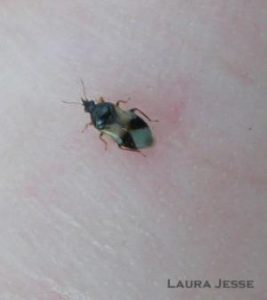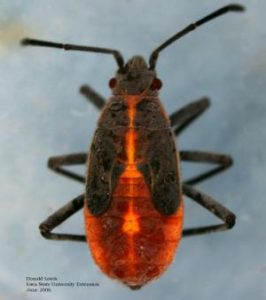CLICK HERE for the latest market quotes from the Iowa Agribusiness Network!
CLICK HERE for the latest market quotes from the Brownfield Ag News Network!
CLICK HERE for the latest market quotes from the Iowa Agribusiness Network!
CLICK HERE for the latest market quotes from the Brownfield Ag News Network!
(Radio Iowa) – The John Deere plant in Ottumwa sat quiet and the parking lot was empty as its workers went on strike early this (Thursday) morning, and about a hundred people began picketing outside of the company’s gates. Some motorists stopped to give food and water to the workers while several more honked their horns as they passed by to show their support for the striking employees.
Trucks entered and left the factory throughout the morning. A cheer rose from the picket line as a truck did -not- enter the facility. A worker who did not want to be identified explained. “You see, there’s been truckers driving by being in solidarity with us and not crossing our picket line,” said the worker. “Some of them are. Some of them aren’t. We’re cheering them on and booing the ones that do.”

Deere employees in the Quad Cities. (WVIK photo via Radio Iowa)
In a statement, Brad Morris, Vice President of Labor Relations for Deere and Company says Deere is “determined to reach an agreement with the United Auto Workers that would put every employee in a better economic position and continue to make them the highest paid employees in the agriculture and construction industries.”
The statement from John Deere concluded by saying the timetable of the two sides coming to an agreement is unknown.
(Radio Iowa) – Iowa needs targeted investments to strengthen and expand its electrical grid to prepare for extreme weather events brought on by climate change. That’s the recommendation from the latest Iowa Climate Statement being released by a coalition of more than 200 researchers. Iowa State University engineering professor Jim McCalley says the extensive power outages from last year’s derecho showed clear vulnerabilities in the state’s infrastructure. “We need to reduce impact and increase speed of restoration and recovery during extreme events,” McCalley says. “This requires diversification in the ways that we supply power. It means, for example, deploying microgrids for loads providing critical services such as hospitals and grocery stores.”
Utility companies should be making investments now, he says, to bolster Iowa’s electric grid. McCalley says, “The future is going to bring winds, extreme temperature evens, floods and droughts at a frequency and severity exceeding conditions for which much of this equipment was designed.” Fortifying the grid will also allow for more wind and solar development, which McCalley says is key to zeroing out emissions. “The transmission capacity that we currently have is insufficient to build out the resources that we need to hit zero carbon,” McCalley says. “That’s not an opinion. It’s a fact.”
The authors of the Climate Statement are calling on residents and regulators to push utilities to make the investments.
On the web at https://iowaenvironmentalfocus.org/iowa-climate-statement/
(reporting by Kate Payne, Iowa Public Radio)
(Ankeny, Iowa/KCCI) —More than 10,000 Deere & Co. workers went on strike after negotiators couldn’t deliver a new agreement. KCCI says in a statement, The United Auto Workers said “members struck at midnight October 14, after the company failed to present an agreement that met our members’ demands and needs.” The vast majority of the union rejected a contract offer earlier this week that would have delivered 5% raises to some workers and 6% raises to others. Thirty-five years have passed since the last major Deere strike, but workers are emboldened to demand more this year after working long hours throughout the pandemic and because companies are facing worker shortages.
UNION DEMANDS:
The workers at the Ankeny, Iowa, plant are asking John Deere for a raise and better retirement benefits. John Deere is expected to post record profits this year. The average production worker at Deere made about $60,000 last year but could see up to $72,000 by the end of negotiations.
HARVEST IMPACT
Farmers say their future is uncertain as those John Deere workers go on strike. One Linn County farmer told KCRG the impact goes beyond workers, stockholders and the company. If they don’t have a part that’s usually in stock, the harvest season could come to a halt.
(Radio Iowa) – The U-S-D-A is rolling out a new insurance option designed for producers with small farms who sell locally. It’s called the Micro Farm Policy and it simplifies record-keeping and covers post-production costs like washing and value-added programs. Iowa Farmers Union president Aaron Lehman (LAY-mun) sees this as a great option for beginning and small-to-medium-sized farmers. “For that type of farmer, there tends to be a lack of support mechanisms that are in place for more traditional farmers,” Lehman says, “and it’s a big barrier for our next generation of farmers and our farmers who want to connect with their local communities through growing local and regional food.”
Lehman says the Micro Farm Policy promises to fit well with producers who are looking to grow their operations in new directions. “It’s not just those who are new to farming,” Lehman says. “It’s for farmers who want to diversify their farm operation and branch into different operations. A modified whole-farm policy that is more accessible, is certainly a big part of it.” Lehman says a wide range of Iowa farmers can use this type of insurance program. “We have a lot of farmers who need the enhanced services that this might provide,” he says, “so we’ll see how the roll-out goes and how it comes from here.”
The Micro Farm Policy will be available beginning with the 2022 crop year through Whole Farm Revenue Protection.
(Radio Iowa) – A proposal to build what’s called the world’s largest carbon dioxide pipeline is drawing opposition from Iowa farmers and environmentalists. Summit Carbon Solutions plans to build 700 miles of pipeline across Iowa to capture carbon from ethanol plants and bury it deep underground in North Dakota.
Beth Richards’ family farms in Hardin County, which is in the proposed path, and she questions how landowners would benefit from the project. “Why should landowners welcome encroachment on their land for a project that doesn’t pay direct dividends to them other than a vague promise that ethanol is good for corn prices,” Richards says. “And why isn’t rent going to be paid for the land or profits shared with farmers?” Summit officials say they see the project as a way to keep ethanol viable and secure a market for Iowa corn. In a public meeting Tuesday, Iowa resident John Norris said the project is a false solution to climate change.
“As much as the ethanol industry is important to Iowa, it is an industry that’s on the decline,” Norris says. “The next two decades we will see a continued decrease in the demand for ethanol. We need to start planning for what’s next.” Summit is in the process of holding public meetings in the 30 Iowa counties the pipeline would pass through. After the meetings are held, the company can petition state regulators for a permit.
(by Kate Payne, Iowa Public Radio)
(Radio Iowa) – A Jackson County man who used a government cattle loan for his personal expenses will spend ten months in federal prison. Twenty-six-year-old Brian Robert Detwiler of Bellevue pleaded guilty to one count of conversion of property pledged to a farm credit agency.
In his plea agreement, he admits he got a 50-thousand dollar U-S-D-A loan to buy cattle and then used some of the money for work on his house, gambling, food, and alcohol. He did buy 35 head of cattle for 32-thousand dollars — then sold 22 head for a profit — and used the money in casinos and bars.
(Radio Iowa) – Bugs are starting to become more of a nuisance as we head into fall. Iowa State University Entomology Professor, Donald Lewis, says minute pirate bugs help the environment until this time of year when they can cause humans pain.

Pirate bug (ISU Extension photo)
“Now there’s not much out in the field for them and they wander around looking for something moist,” Lewis says. “And if you happen to be on your ladder in your short-sleeved shirt painting the white side of your house — they’re going to find you, and they’re going to be attracted to the reflective light. They are going to taste you to see if are you an insect egg, or are you a source of moisture. And that’s why they bite.”
Lewis says boxelder bugs can also cause nuisances this time of year as they prepare to hibernate during the winter. “One cheap and easy way to control boxelder bugs outdoors is to spray them with soapy water,” he says. That keeps them under control in the short term. “Now that has no residual. That will not control the boxelder bugs that come an hour later. But the ones that are there now, the ones that are massed in the late afternoon, you can kill them with a soapy spray, but you are going to have to do it probably every day for best results,” according to Lewis.
Lewis says the Minute Pirate Bugs will die once the freezing temperatures come.

Boxelder bug (ISU Ext.)
(Anita, Iowa) – In about two-weeks, the Food Bank of the Heartland’s Mobile Food Pantry will be coming to Anita. Cass County Wellness Coordinator Brigham Hoege says anyone, including people from the surrounding communities, are welcome to visit the mobile food pantry, with no documentation is needed. The drive-through mobile food pantry will be at 208 Chestnut Street in Anita on October 27, from 5:30 p.m. to 7:00 p.m., or as long as supplies last.
The mobile pantry is a traveling food pantry delivering food directly to families in need for a one-day distribution. It is free of charge. Visitors are asked to stay in their vehicles with the trunk open, so volunteers may load the food items into your vehicle.
For more information on local food, farmers’ markets, and food access, follow the Cass County Local Food Policy Council’s Facebook page @CassCountyLocalFood or contact Food Bank for the Heartland at 402-315-2555.